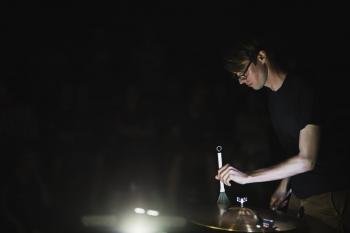Arts, Science + Culture Profile: Ted Moore
By Lee Jasperse
Graduate Management Fellow
We are excited to feature the work of 2019–20 Arts, Science + Culture Initiative Graduate Fellow Ted Moore (PhD student, Department of Music). Meeting on a monthly basis, the Arts, Science + Culture Graduate Fellows program brings together UChicago graduate students to share concepts, methodologies, and research questions across disciplines.
Ted Moore’s music is eerie. It drones, it rumbles, slowly picking up steam before plunging you into the ravages of random sound, the noise of a demonic algorithm: inhuman but not inanimate. It has that uneasy and suspenseful quality that would make a perfect soundtrack for a horror film as we watch the protagonist inch closer and closer down a dark hallway toward inevitable disaster—only it has a dazzling geometric complexity to it, so imagine that hallway made into a kaleidoscopic labyrinth where the terror is the total claustrophobic impossibility of escape.
This, to me, is the moody ritualism Ted’s music conjures. It’s a bit surprising, then, that when Ted talks about his composition practice, he talks about wanting his music to manifest “intimacy” and the “manifolds of possibility” between the instruments, musicians, audience members, and performance space in a given concert. His music may be eerie, yes, but it’s an eeriness that stems from the fact that his music spurns melody or anything like a pre-scripted order in favor of “novel collections of sounds” that manage to constantly excite and surprise.
Ted has been composing with computers since 2007 to achieve this unrelenting newness. He uses algorithms, glitches, and sonic feedback to produce his distinctive sound. For example, his performances sometimes feed instrumental tones through inputs that randomly modulate them, incorporates electromagnetic feedback (like when a microphone screeches in this piece), and features the warping of analogue technology, like winding cassette tapes. These tools subject an input to random distortion or deviation, transforming what was a known collection of sounds in unexpected ways.
The unexpected quality of Ted’s work is compounded by the emphasis he places on improvisation: rather than write a score or script of computational operations, Ted finds possibility in working with uncertainty, under conditions that demand risk-taking in relinquishing control over what exact sounds will be produced from one moment to the next. There’s an undying elasticity involved in this sort of composing: instead of a piece fixed in its note sequence, Ted strains toward what he calls the “vibrancy of systems,” shimmering with the new and unexpected.
When Ted talks about the intimacy he aspires to, it’s the intimacy of inhabiting a sound-space collectively, as it’s emerging into being. Each participant at one of his performances is similarly “in the dark” as to what’s to come, riding the new chasms of noise opened up by the permutations of sound. Ted talks about all the sounds that could be produced in a performance as “manifold as possibility,” an infinite field of arrangements of sound that he could produce. As a composer writing a score, he can only access so much of that field of possibility. But by incorporating glitches and other sorts of randomness, he lets accident access new, untapped pockets of sound that he could not have arrived at by himself.
“It gives the technological systems a sense of agency,” Ted told me. “The system comes to feel like a collaborator.” As an improviser, then, he’s something like a ship captain, steering the performance across waves of music generated by algorithm and accident.
The most important collaborator for him, however, is not technological but social: it’s the people in the room. The size of the audience and his familiarity with them will determine whether he takes more or fewer risks with the improvisation. If there are a lot of fellow composers in the room, he’ll sometimes reference their music or throw in an inside joke. He’ll also play off previous music in that performance’s program, lightening the mood if the audience has just endured something particularly dark—or vice versa.
So even though Ted’s music can sound drone-y and machinic, it is eminently alive, teeming with social dynamics—resonating the “vibrancy of systems” (harmonic, social, and generic) alive in ways unique to each performance situation.

